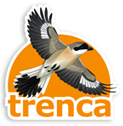
A bearded vulture is flying off with food in the beak; on the right, two Griffon vultures and two black vultures; in the background, ravens. Picture obtained by photo-trapping at Siall SFP. © Trenca
Griffon Vulture, Black Vulture, Egyptian Vulture, Bearded Vulture, Red Kite and Black Kite use Trenca´s feeding stations (or supplementary feeding points, SFP).
On next Saturday 30 August we will organize an open doors day at Siall feeding station (Isona, Pallars Jussà) and we will see how they feed.
On next Saturday 30 August at 10:30, to coincide with the International Vulture Awareness Day, we will be organizing an open doors activity at the feeding station of Siall. From the hide (there will be signs saying how to get it) we will see scavenger raptors feeding. To get the place: take the Isona road heading Coll de Nargó, and later on take the turning towards Siall (Pallars Jussà regional district).
The Black Vulture is being reintroduced in the Pyrenees since 2007, in the Boumort-Alinyà area. At Siall SFP, which is besides the National Hunting Reserve of Boumort, we can often watch them (it would be rare that they would not come in; usually, between 3 and 5 individuals are observed each time food is supplied; 11 different individuals have been observed at the same time at this SFP). This species is also using the Bassella SFP and the Cal Roger SFP, but in a more timely manner.
The Griffon Vulture is the most abundant species in the three Trenca’s SFP. At Siall we can easily watch more than 150 individuals.

Black vultures flying over a feeding station. © Boumort-Alinyà team.
The Egyptian Vulture is a migratory bird of prey, that goes to Africa in Autumn and comes back to Europe next Spring. Adults have got a white and black plumage, as the one from the white storks; juveniles are brown. We can watch them at the three Trenca’s SFP since the first days of March until October, mainly at Siall and Bassella SFPs. At Siall we can easily watch between 2 and 5 individuals each time food is supplied.
The Bearded Vulture is using Siall and Cal Roger SFPs, both adults (with eminent yellowish-brown feathers on the belly) and juveniles (which have got a blackish plumage). It has also been observed at Bassella SFP, but just flying around, there is no evidence so far that the species is using this SFP to feed. We could see him at Siall on next Saturday 30.

Griffon vulture at Cal Roger (or Montferrer) SFP, last Spring. Picture obtained by photo-trapping. © Trenca

Egyptian vulture at Bassella SFP, last Spring. Picture obtained by photo-trapping. © Trenca

Bearded vulture at Siall SFP, last Spring. Picture obtained by photo-trapping. © Trenca
The Black Kite is also a migratory bird of prey. We can watch them feeding at any of the three Trenca’s SFP from March on, until Autumn. At Siall SFP we can easily watch 4 or 5 individuals when supplying the food.
The Red Kite is all year around (in wintertime, some more individuals come from the North of Europe). We can watch them quite easily at any of the three SFP. At the one of Siall we can easily watch 4 or 5 individuals when supplying the food.

Red kite at Cal Roger (or Montferrer) SFP, last Winter. Picture obtained by photo-trapping. © Trenca

Black kite at Siall SFP, this Summer. Picture obtained by photo-trapping. © Trenca
The SPF (Supplementary Feeding Points) network project from Trenca Association has set up three sites in the Pre-Pyrenees and Pyrenees of Lleida (Siall, Bassella and Cal Roger) where scavenger birds of prey can find food in a safe way. The SFPs aim is to ease the lack of food for all these species, which are key to the ecological balance of ecosystems, reinforcing the availability of food for these birds in the Pyrenees. Besides, the operating of the three SFP is directly related to the reintroduction of the Black Vulture in the Pyrenees.



